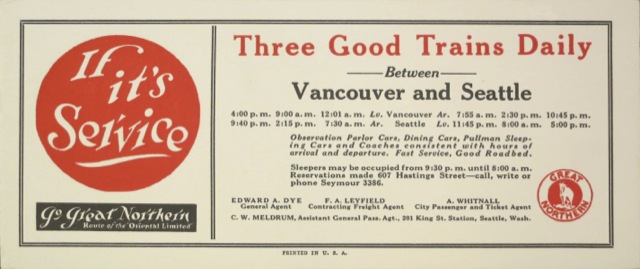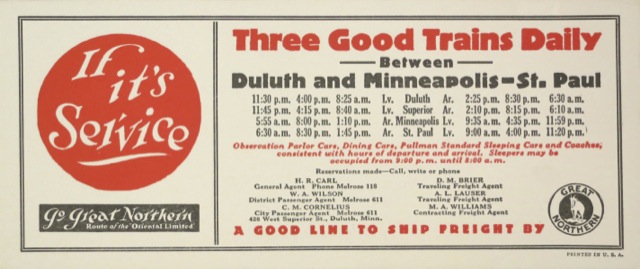“If its Service, Go Great Northern,” say these two blotters. What the heck does that mean? It must mean, “If you want good service, go Great Northern.”

Click images to download a 0.4-MB PDF of each blotter.
The real message of the blotters is that GN offered “three good trains daily” between Seattle and Vancouver, BC and three more good trains daily between Minneapolis-St. Paul and Duluth. GN had no rail competition on the route between Seattle and Vancouver.
On the Duluth-Twin Cities route, however, GN competed with three NP trains and two on the Soo Line. All three railroads had overnight trains leaving close to midnight and arriving a leisurely 6-1/2 to 7-1/2 hours later. They also had afternoon trains spaced about an hour apart, while NP and GN each had morning trains leaving around 9 am and arriving mid-afternoon.
Curiously, GN’s route from Duluth arrived in Minneapolis before going to St. Paul while NP’s route arrived in St. Paul first. The two railroads use the same tracks between Minneapolis and St. Paul, so their trains going to (or from) Duluth would meet going in opposite directions between Minneapolis and St. Paul.
This also meant that GN would offer Minneapolis residents going to Duluth a small advantage as GN’s fastest train to Minneapolis was 20 minutes faster than NP’s and 35 minutes faster than the Soo Line’s day train. This didn’t matter much for overnight travelers, who preferred a longer trip so they wouldn’t have to get up early, but might have made a small difference to daytime passengers. Conversely, of course, GN trains between Duluth and St. Paul took a few minutes longer than NP’s or the Soo Line’s.

